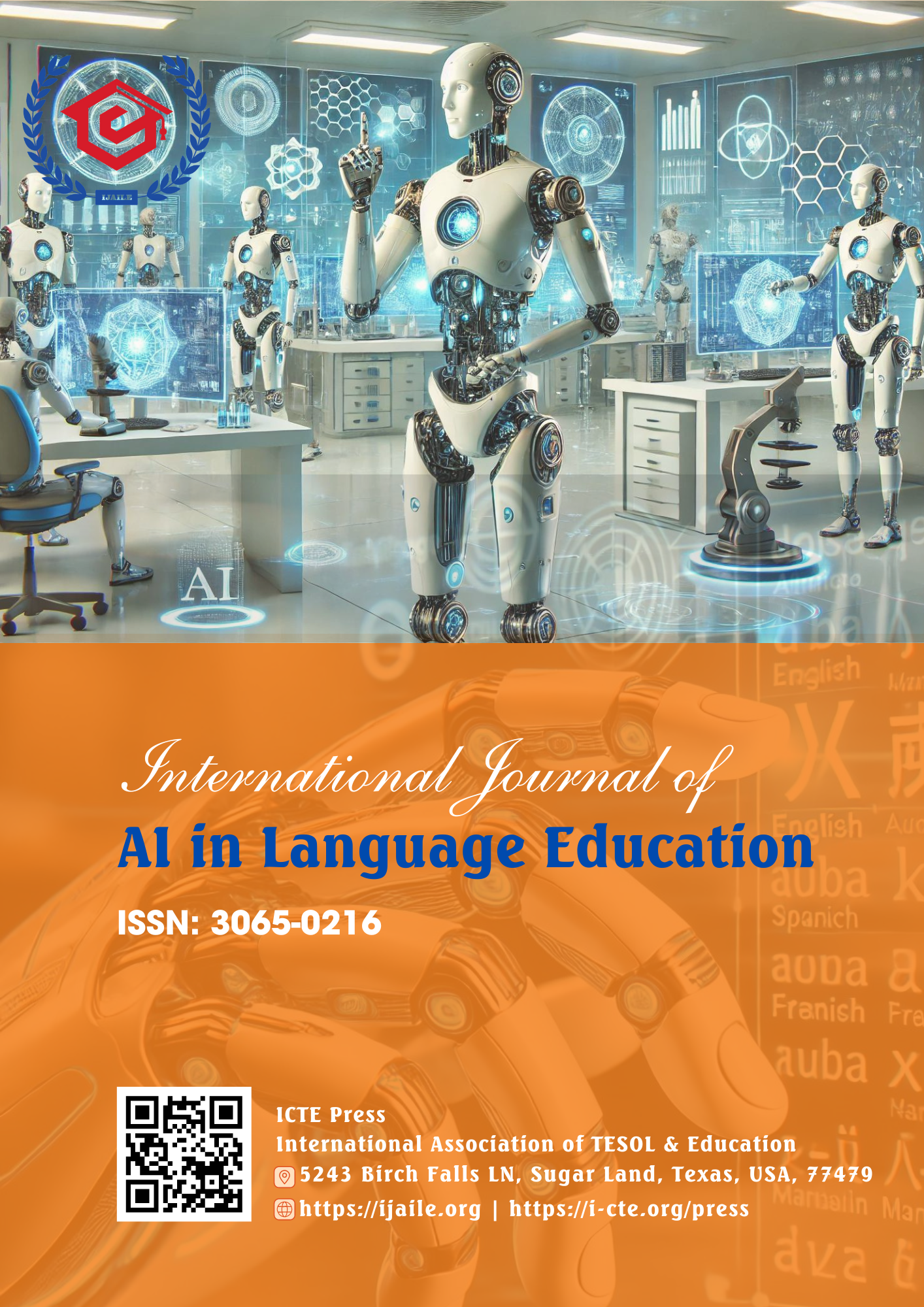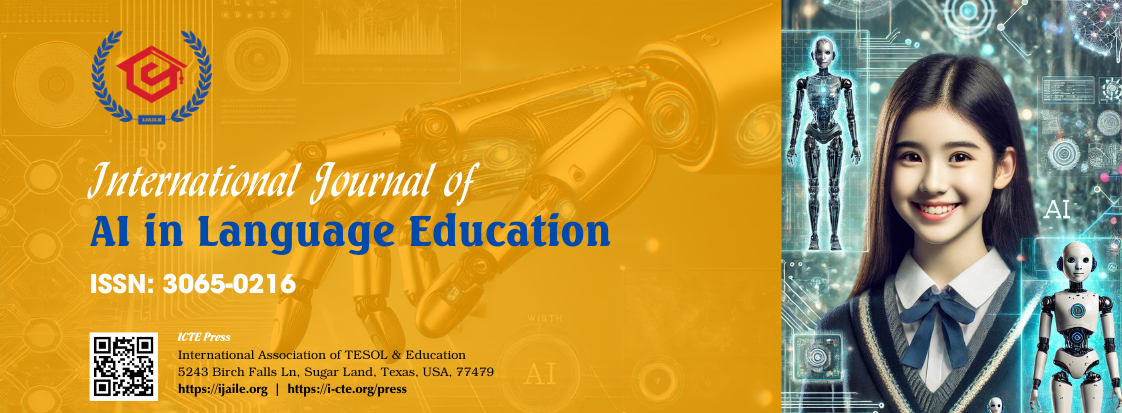Exploring the Effects of an AI Chatbot on Emotional Engagement in English Speaking Lessons: Insights from Call Annie
DOI:
https://doi.org/10.54855/ijaile.25225Keywords:
Generative AI, students' engagement, virtual conversational partner, willingness to communicate.Abstract
The use of artificial intelligence (AI) in English language teaching is becoming more common, especially in enhancing students’ confidence levels in speaking lessons. Existing literature has provided insights into how AI can be incorporated to facilitate students' learning in diverse contexts, although the number of studies on how AI chatbots can improve students' emotional engagement is limited. This study aims to explore how using an AI tool called Call Annie affects students’ emotional and behavioral engagement when assigned as homework. 77 English-majored students participated in a three-week project where they used the application to have regular conversations with Call Annie – an AI-powered conversational agent. Two questionnaires were administered in the first and third weeks. Emotional engagement levels, regarding confidence and anxiety, concerns, and behavioral degree related to willingness to communicate (WTC) were compared using a paired-sample T-Test. The results indicated increased levels of confidence and WTC, despite some ongoing concerns about the use of the tool. These findings suggest that Call Annie can enhance emotional engagement, paving the way for more personalized learning experiences through the use of AI chatbots.
References
Afkarin, M. Y., & Asmara, C. H. (2024). Investigating the Implementation of ChatGPT in English Language Education: Effects on Student Motivation and Performance Levels. Journey: Journal of English Language and Pedagogy, 7(1), 57–66. https://doi.org/10.33503/journey.v7i1.865 DOI: https://doi.org/10.33503/journey.v7i1.865
Auernhammer, J. (2020). Human-centered AI: The role of Human-centered Design Research in the development of AI. https://doi.org/10.21606/drs.2020.282 DOI: https://doi.org/10.21606/drs.2020.282
Bao, D. (2019). The place of silence in second language acquisition. English Language Teaching and Research Journal (ELTAR-J), 1(1), 26-42. DOI: https://doi.org/10.33474/eltar-j.v1i1.4771
Byrne, B. M. (2010). Basic concepts, applications, and programming. Structural equation modeling with AMOS, 396, 227.
Chan, C. K. Y., & Hu, W. (2023). Students’ voices on generative AI: Perceptions, benefits, and challenges in higher education. International Journal of Educational Technology in Higher Education, 20(1), 43. https://doi.org/10.1186/s41239-023-00411-8 DOI: https://doi.org/10.1186/s41239-023-00411-8
Chan, C. K. Y., & Tsi, L. H. (2023). The AI revolution in education: will AI replace or assist teachers in higher education? https://doi.org/10.48550/arXiv.2305.01185
Creswell, J. W., & Clark, V. L. P. (2017). Designing and conducting mixed methods research. Sage publications.
Dasborough, M. T. (2023). Awe‐inspiring advancements in AI: The impact of ChatGPT on the field of Organizational Behavior. Journal of Organizational Behavior (John Wiley & Sons, Inc.), 44(2). https://doi.org/10.1002/job.2695 DOI: https://doi.org/10.1002/job.2695
Duong, T., & Suppasetseree, S. (2024). The effects of an artificial intelligence voice chatbot on improving Vietnamese undergraduate students’ English speaking skills. International Journal of Learning, Teaching and Educational Research, 23(3), 293-321. https://doi.org/10.26803/ijlter.23.3.15 DOI: https://doi.org/10.26803/ijlter.23.3.15
Dornyei, L. (2005). The psychology of the language learners: Mahwah. New Jorzy: Laurence Ulbanm Associates. https://tesl-ej.org/wordpress/issues/volume10/ej37/ej37r7/?wscr=
El Shazly, R. (2021). Effects of artificial intelligence on English speaking anxiety and speaking performance: A case study. Expert Systems, 38(3), e12667. https://doi.org/10.1111/exsy.12667 DOI: https://doi.org/10.1111/exsy.12667
Fathi, J., Derakhshan, A., & Ebrahimi Galedar, D. (2023). An investigation of the relationship between teacher self-efficacy and teacher academic optimism among Iranian EFL teachers: A structural equation modelling approach. Language and Translation Studies (LTS), 55(4), 33-63. https://doi.org/10.22067/jlts.2021.71751.1060
Fathi, J., Rahimi, M., & Derakhshan, A. (2024). Improving EFL learners’ speaking skills and willingness to communicate via artificial intelligence-mediated interactions. System, 121, 103254. https://doi.org/10.1016/j.system.2024.103254 DOI: https://doi.org/10.1016/j.system.2024.103254
Golonka, E. M., Bowles, A. R., Frank, V. M., Richardson, D. L., & Freynik, S. (2014). Technologies for foreign language learning: A review of technology types and their effectiveness. Computer assisted language learning, 27(1), 70-105. https://doi.org/10.1080/09588221.2012.700315 DOI: https://doi.org/10.1080/09588221.2012.700315
Gupta, A., Hathwar, D., & Vijayakumar, A. (2020). Introduction to AI chatbots. International Journal of Engineering Research and Technology, 9(7), 255-258. DOI: https://doi.org/10.17577/IJERTV9IS070143
Huang, L. (2023). Ethics of artificial intelligence in education: Student privacy and data protection. Science Insights Education Frontiers, 16(2), 2577-2587. https://doi.org/10.15354/sief.23.re202 DOI: https://doi.org/10.15354/sief.23.re202
Jumriah, J., Susilawati, E. S., Supriatna, E., Smas, M. H., & Arini, I. (2024). Analysis of the Use of GPT Chat to Improve Student Performance. EDUKASIA: Jurnal Pendidikan Dan Pembelajaran, 5(1), 127-136. https://doi.org/10.62775/edukasia.v5i1.725 DOI: https://doi.org/10.62775/edukasia.v5i1.725
Kang, S., & Sung, M. C. (2024). EFL students' self-directed learning of conversation skills with AI chatbots. Language Learning & Technology, 28(1), 1-19 (ISSN: 1094-3501). https://hdl.handle.net/10125/73600
Khasawneh, M. A. S. (2023). Integrating Ai-Based Virtual Conversation Partners in Enhancing Speaking Skills In Foreign Languages: Insights From University Students. Journal of Southwest Jiaotong University, 58(5), 575-587. http://jsju.org/index.php/journal/article/viewFile/1861/1850 DOI: https://doi.org/10.35741/issn.0258-2724.58.5.43
Khajavy, G. H., MacIntyre, P. D., & Hariri, J. (2021). A closer look at grit and language mindset as predictors of foreign language achievement. Studies in Second Language Acquisition, 43(2), 379-402. https://doi.org/10.1017/S0272263120000480 DOI: https://doi.org/10.1017/S0272263120000480
Kumar, M. V., Ramesh, G. P., Pareek, P. K., Deepak, H. A., & Babu, J. A. (2023, June). Robotic Attendance Scheme in the Classroom Using Artificial Intelligence and Internet of Things. In 2023 International Conference on Applied Intelligence and Sustainable Computing (ICAISC) (pp. 1-6). IEEE. https://dialnet.unirioja.es/servlet/articulo?codigo=9869857 DOI: https://doi.org/10.1109/ICAISC58445.2023.10200650
Le, T., Nguyen, X., Dang, H., Pham, T., & Nguyen, L. (2025). Automated Writing Evaluation (AWE) in Vietnamese EFL Classrooms: Enhancing skills and understanding Student perception. Journal of Science and Technology - Industrial University Ho Chi Minh City, 73 (ISSN: 2525-2267). https://jst.iuh.edu.vn/index.php/jst-iuh/article/view/5095
Liu, W., & Wang, Y. (2024). The effects of using AI tools on critical thinking in English literature classes among EFL learners: An intervention study. European Journal of Education, 59(4), e12804. https://doi.org/10.1111/ejed.12804 DOI: https://doi.org/10.1111/ejed.12804
Marmolejo-Ramos, F., Workman, T., Walker, C., Lenihan, D., Moulds, S., Correa, J. C., ... & Sonna, B. (2022). AI-powered narrative building for facilitating public participation and engagement. Discover Artificial Intelligence, 2(1), 7. DOI: https://doi.org/10.1007/s44163-022-00023-7
MacIntyre, P. D., Clément, R., Dörnyei, Z., & Noels, K. A. (1998). Conceptualizing willingness to communicate in a L2: A situational model of L2 confidence and affiliation. The modern language journal, 82(4), 545-562. https://doi.org/10.1111/j.1540-4781.1998.tb05543.x DOI: https://doi.org/10.1111/j.1540-4781.1998.tb05543.x
Muñoz, S. A. S., Gayoso, G. G., Huambo, A. C., Tapia, R. D. C., Incaluque, J. L., Aguila, O. E. P., ... & Arias-Gonzáles, J. L. (2023). Examining the impacts of ChatGPT on student motivation and engagement. Social Space, 23(1), 1-27.
Ni, A., & Cheung, A. (2023). Understanding secondary students’ continuance intention to adopt AI-powered intelligent tutoring system for English learning. Education and Information Technologies, 28(3), 3191-3216. https://doi.org/10.1007/s10639-022-11305-z DOI: https://doi.org/10.1007/s10639-022-11305-z
Nguyen, L. A. D., Dang, V. M. T., & Le, M. T. (2025). An investigation into Students' Perception of Using Call Annie as a Virtual Conversational Partner. Proceedings of the AsiaCALL International Conference, 6, 344-364. ISSN: 2833-6836, ISBN: 979-8-9870112-6-3. DOI: https://doi.org/10.54855/paic.24624 DOI: https://doi.org/10.54855/paic.24624
Nguyen, V. L. (2024). The Impact of Online Resources via Personal Devices on English-Majored Students’ Learning Practices. International Journal of Language Instruction, 3(4), 110-118. https://doi.org/10.54855/ijli.24346 DOI: https://doi.org/10.54855/ijli.24346
Pham, T. T., Nguyen , L. A. D., Dang, H. M., & Le, T. T. P. (2024). Exploring Tertiary Vietnamese EFL Students’ Engagement in Vocabulary Learning through the Use of an AI Tool. Proceedings of the AsiaCALL International Conference, 4, 129–149. https://doi.org/10.54855/paic.23410 DOI: https://doi.org/10.54855/paic.23410
Pham, N. Q. N. (2024). The Perspectives of Post-graduates Majoring in English Regarding the Usage of QuillBot to Enhance Paraphrasing Skills. International Journal of AI in Language Education, 1(1), 29-40.https://doi.org/10.54855/ijaile.24113 DOI: https://doi.org/10.54855/ijaile.24113
Pang, S., Nol, E., & Heng, K. (2024). Generative AI as a personal tutor for English language learning: A review of benefits and concerns. https://ssrn.com/abstract=4865398 or http://dx.doi.org/10.2139/ssrn.4865398 DOI: https://doi.org/10.2139/ssrn.4865398
Rad, H. S., R. Alipour, and A. Jafarpour. 2023. “Using Artificial Intelligence to Foster Students' Writing Feedback Literacy, Engagement, and Outcome: A Case of Wordtune Application.” Interactive Learning Environments: 1–21. https://doi.org/10.1080/10494820.2023.2208170. DOI: https://doi.org/10.1080/10494820.2023.2208170
Sharma, B. (2023). Call Annie: New App Brings ChatGPT To Life With Human-Like Conversations And An Avatar. https://www.indiatimes.com. Retrieved April 11, 2024, from https://www.indiatimes.com/technology/news/call-annie-new-app-brings-chatgpt-to-life-601056.html
Shin, D., Kim, H., Lee, J. H., & Yang, H. (2021). Exploring the use of an artificial intelligence chatbot as second language conversation partners. Korean journal of English language and linguistics, 21(21), 375-391. https://doi.org/10.15738/kjell.21..202104.375
Shiri, A. (2023) ChatGPT and Academic Integrity. Information Matters. https://informationmatters.org/2023/02/chatgpt-and-academic-integrity/ DOI: https://doi.org/10.2139/ssrn.4360052
Sok, S., & Heng, K. (2023). ChatGPT for education and research: A review of benefits and risks. Cambodian Journal of Educational Research, 3(1), 110-121. DOI: https://doi.org/10.62037/cjer.2023.03.01.06
Su, A. A. T., & Tran, T. H. N. (2024). The Benefits and Weaknesses of Chat GPT on Students’ Learning Writing. International Journal of AI in Language Education, 1(1), 20-28.https://doi.org/10.54855/ijaile.24112 DOI: https://doi.org/10.54855/ijaile.24112
Tai, T. Y., & Chen, H. H. J. (2024). Improving elementary EFL speaking skills with generative AI chatbots: Exploring individual and paired interactions. Computers & Education, 220, 105112. https://doi.org/10.1016/j.compedu.2024.105112 DOI: https://doi.org/10.1016/j.compedu.2024.105112
Tlili, A., Shehata, B., Adarkwah, M. A., Bozkurt, A., Hickey, D. T., Huang, R., & Agyemang, B. (2023). What if the devil is my guardian angel: ChatGPT as a case study of using chatbots in education. Smart learning environments, 10(1), 15. https://doi.org/10.1186/s40561-023-00237-x DOI: https://doi.org/10.1186/s40561-023-00237-x
Tran , H. N., Le, T. T. N., & Tran, V. B. U. (2025). AI Tools in Learning Academic Writing: Benefits and Challenges for MA Students in the English Language Studies at the Industrial University of Ho Chi Minh City. International Journal of AI in Language Education, 2(1), 74-91. https://doi.org/10.54855/ijaile.25215 DOI: https://doi.org/10.54855/ijaile.25215
Truong, T. A. A., Le, H. K. N., & Nguyen, V. H. Q. (2025). English-Major Master’s Students Regarding the Use of ChatGPT in Learning Research Writing at IUH. International Journal of AI in Language Education, 2(1), 92-115. https://doi.org/10.54855/ijaile.25216 DOI: https://doi.org/10.54855/ijaile.25216
Wan, Y., & Moorhouse, B. L. (2024). Using Call Annie as a generative artificial intelligence speaking partner for language learners. RELC Journal, 00336882231224813. https://doi.org/10.1177/00336882231224813 DOI: https://doi.org/10.1177/00336882231224813
Wang, C., Zou, B., Du, Y., & Wang, Z. (2024). The impact of different conversational generative AI chatbots on EFL learners: an analysis of willingness to communicate, foreign language speaking anxiety, and self-perceived communicative competence. System, 127, 103533. https://doi.org/10.1016/j.system.2024.103533 DOI: https://doi.org/10.1016/j.system.2024.103533
Wang, Y., & Xue, L. (2024). Using AI-driven chatbots to foster Chinese EFL students’ academic engagement: An intervention study. Computers in Human Behavior, 159, 108353. https://doi.org/10.1016/j.chb.2024.108353 DOI: https://doi.org/10.1016/j.chb.2024.108353
Xu, X., Dugdale, D. M., Wei, X., & Mi, W. (2023). Leveraging artificial intelligence to predict young learner online learning engagement. American Journal of Distance Education, 37(3), 185-198. https://doi.org/10.1080/08923647.2022.2044663 DOI: https://doi.org/10.1080/08923647.2022.2044663
Yang, H., Kim, H., Lee, J. H., & Shin, D. (2022). Implementation of an AI chatbot as an English conversation partner in EFL speaking classes. ReCALL, 34(3), 327-343. https://doi.org/10.1017/S0958344022000039 DOI: https://doi.org/10.1017/S0958344022000039
Yashima, T. (2002). Willingness to communicate in a second language: The Japanese EFL context. The modern language journal, 86(1), 54-66. https://doi.org/10.1111/1540-4781.00136 DOI: https://doi.org/10.1111/1540-4781.00136
Younas, M., El-Dakhs, D. A. S., & Jiang, Y. (2025). A comprehensive systematic review of AI-driven approaches to self-directed learning. IEEE Access. https://ieeexplore.ieee.org/abstract/document/10906568 DOI: https://doi.org/10.1109/ACCESS.2025.3546319
Yu, H., Liu, Z., & Guo, Y. (2023, April). Application Status, Problems and Future Prospects of Generative ai in education. In 2023 5th International Conference on Computer Science and Technologies in Education (CSTE) (pp. 1-7). IEEE. https://doi.org/10.1109/CSTE59648.2023.00065 DOI: https://doi.org/10.1109/CSTE59648.2023.00065
Yuan, Y. (2024). An empirical study of the efficacy of AI chatbots for English as a foreign language learning in primary education. Interactive Learning Environments, 32(10), 6774-6789. https://doi.org/10.1080/10494820.2023.2282112 DOI: https://doi.org/10.1080/10494820.2023.2282112
Zhou, W. (2023). Chat GPT Integrated with Voice Assistant as Learning Oral Chat-based Constructive Communication to Improve Communicative Competence for EFL learners. https://doi.org/10.48550/arXiv.2311.00718
Downloads
Published
Issue
Section
License
Copyright (c) 2025 Nguyen Lam Anh Duong, Le Thi Thien Phuoc (Author)

This work is licensed under a Creative Commons Attribution 4.0 International License.












